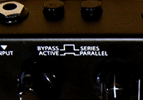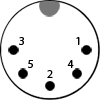Triad Rev 1 Controls
Note: this version of the Triad was produced between 2005 and 2010. Full documentation for this version is retained on these pages, and all owners of the original Triad will continue to have full support from Psionic Audio.
Choose a Triad control above to find out more about its operation. While the Triad is intuitive and can be used right out of the box without looking at the manual, there are some options and uses that are not obvious at first glance.
Preamp Level Control
This controls the level of the preamp when the Triad is turned on (blue LED is lit). The knob is at unity when fully counterclockwise and offers a maximum gain increase of 30dB when fully clockwise (this is an extreme amount of gain). I suggest starting out with the preamp Level at unity and then turning it up slowly, listening to how the amp sounds and reacts as the gain increases.
Unless the Preamp Level is cranked, the Triad itself has tons of headroom, so it will get along with just about any pedal used in front of it. If you have a Overdrive or Distortion pedal that you love with your amp, you'll still love it in front of the Triad.
FX/Boost 1 Send Level Control
This controls how much signal is sent out to the loop, and affects both Parallel and Series modes. Unity is fully clockwise, and fully counterclockwise is off - no signal is sent to the loop.
If you have a delay or reverb, etc, in the loop, using parallel mode, you can control the amount of effect heard here on the Triad.
FX/Boost 1 Return Level Control
This adjusts the Return level from the loop. Center (with a detent) is unity gain, with 3dB of attenuation fully counterclockwise and 9dB of gain when fully clockwise.
Note than when used in Parallel mode with a cable between the Send and Return jacks, there is an automatic +3dB level increase when the Loop is activated, even with the Return set at unity (noon). In this mode of use, turning the Return fully counterclockwise returns to unity, while turning fully clockwise offers +12dB of gain. This allows the Loop to be used as a second gain stage, separate from the Boost 2 stage.
Note: the Loop is only available if the Preamp is active (with an exception noted in the Bypass/Active Pushbutton section).
Boost 2 Tone Control
The Tone circuit is only active when the Boost 2 stage is engaged. With the Tone knob fully clockwise the Tone control is again out of the circuit. As the knob is turned counterclockwise, the tone circuit is engaged and smoothly rolls off the very high end without losing depth and detail. There is no mud, no nasal honk, and no loss of volume, as are common with most tone controls.
The tone control can be used to make leads fatter, of course, or to tame the slight harshness that some amps (particularly Fender blackfaced amps) exhibit when the input is hot.
Boost 2 Level Control
The Boost 2 section is simple. Whatever level the Preamp is set at (plus whatever boost might be added from Stage 2) can have an additional 10dB of gain added on top. Setting the Boost 2 knob fully counterclockwise sets the gain at unity, defeating the Boost but turning on the Tone control. As the Boost 2 knob is turned clockwise, more gain is added.
Note: the Boost 2 is only available if the Preamp is active.
Output and Input Jacks
High quality rugged nickel-ringed Neutrik jacks, offering long life, reliable contacts with a large surface area, a secure connection to the chassis, and an intelligent separation of audio ground from chassis/shield ground.
Oh, and we think they're pretty.
If nothing is plugged into the Input, then the circuit is grounded out, muting your amplifier.
Bypass/Active Switch
 This one's a little sneaky.
With this pushbutton switch depressed, the Triad operates as you would expect. If this switch
is out, though, then the signal is routed directly from the Input jack to the Send and then from
the Return to the Output, regardless of whether the Triad Preamp, Loop,
or Boost are active. This lets you use any delay, reverb, or other effects
you might place in the Triad loop without using the Triad preamp.
This one's a little sneaky.
With this pushbutton switch depressed, the Triad operates as you would expect. If this switch
is out, though, then the signal is routed directly from the Input jack to the Send and then from
the Return to the Output, regardless of whether the Triad Preamp, Loop,
or Boost are active. This lets you use any delay, reverb, or other effects
you might place in the Triad loop without using the Triad preamp.
If nothing is in the loop, then the output signal is muted. If a straight cable is in the loop, then this is the equivalent of bypassing the Preamp using the footswitch.
Series/Parallel Switch
 With
this pushbutton switch depressed the Triad Loop operates in parallel mode.
With the switch out, the Triad Loop operates in series mode.
With
this pushbutton switch depressed the Triad Loop operates in parallel mode.
With the switch out, the Triad Loop operates in series mode.
Loop Send and Return Jacks
Another obvious one, but there are couple of things here you need to know.
First, the tip of the Return jack is normalled to ground, so if no cable is plugged into the Return jack, the Loop input to the Mixer stage is grounded out, for lowest noise.
Second, the Return jack does not have its ground connected. This is done to prevent ground loops and to prevent the signal cables in the loop from forming an antenna, picking up noise and radio frequencies, particularly at high gain.
Incoming 9vac Power Jack
This is the jack that powers the Triad pedal. It accepts a 2.5mm 9vac supply, with a minimum current requirement of 100ma to operate the Triad by itself, though 1A or greater is recommended if you want to use the 9.6vdc outgoing power jack to supply power to connected pedals.
Outgoing 9.6vdc Power Jack
This jack can provide 9.6vdc power to external pedals. The output is tip negative with a 2.1mm barrel (Boss standard). How many pedals depends on the current needs of the pedals and what power supply you use with the Triad. If you use a recommended 1A or greater supply, you can power up to 900ma worth of external pedals.
It is vital that you do not plug the 9vac supply into the 9.6vdc jack. This can damage the Triad.
External Control Jack
This is an unusual jack that allows for external control of the three primary Triad switching functions: Preamp, FX/Boost 1, and Boost 2.
This can be controlled by a custom interface box in conjunction with a standard MIDI relay switcher, or directly by the (now sadly discontinued but still widely available) Axess Electronics CFX4.
Note: This is NOT a MIDI jack, but does use a 5 pin DIN connection.
The pinout is as follows:

- Preamp switching
- Boost 2 switching
- Ground
- FX/Boost 1 switching
- 9vdc
When a connection is made between the pin associated with a switch and ground, the switch is activated. The 9vdc is provided as a courtesy to power LEDs on possible custom remote switches, but should not be used when connected directly to the Axess Electronics CFX4 or any other MIDI device.
This is all made possible by the use of high quality quiet relays for primary switching functions in the Triad.

